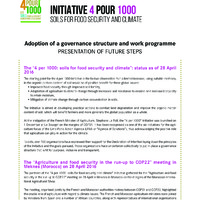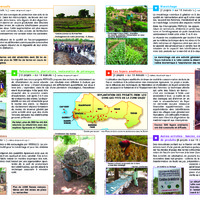Recherche
11 items
Adoption of a governance structure and work programme presentation of future steps
Adoption of a governance structure and work programme PRESENTATION OF FUTURE STEPS
Aménagements anti-érosifs
Les aménagements anti-érosifs sont des ouvrages de protection des sols et de récupération des terres dégradées. Dans les micro-projets, on trouve des cordons pierreux, des banquettes, des demi-lunes, des digues et des diguettes. Ces techniques souvent simples à mettre en œuvre produisent des résultats spectaculaires. Les rendements des terres de cultures bénéficiaires peuvent dans certains cas être multipliés par deux. Cette augmentation est plus importante lorsque les aménagements sont combinés à des actions de fertilisation des sols. Le délai de retour sur investissement est variable selon les contextes. Il est estimé entre 3 et 7 ans. La réussite des aménagements dépend de la qualité de l'accompagnement technique et du degré d'entente entre les différentes communautés concernées sur les sites. La durabilité des ouvrages dépend de la régularité de leur entretien et de leur bonne gestion après réalisation
Bulletin de veille environnementale
Un total de 1 879 386 feux de brousse détectés sur l’ensemble de la zone CILSS/CEDEAO en pendant la saison 2023-2024
Expanding capacity for translating seasonal climate forecasts into actionable information for agriculture and water sectors in West Africa: Lessons learnt and way forward
With climate change and variability posing challenges to sub-Saharan Africa’s development sectors, weather and climate information services are crucial for building climate-resilient development pathways (Hansen et al., 2022). Seasonal forecasts in particular provide prospective information about the upcoming season, with a particular focus on precipitation and temperature (Guido et al., 2020; Hansen et al., 2011). However, a direct and linear translation of the seasonal forecasts to sector-specific information such as water resources and agriculture can lead to inaccurate recommendations. Integrating seasonal forecast data into biophysical models can enable the generation of sector-relevant actionable information that can improve the decision-making (Hansen, 2005; Houngnibo et al 2023). This would contribute to a better understanding of the impacts of climate forecasts in the water and agriculture sectors, among others, thereby facilitating more informed decision-making.
Regional operational meteorological centers, including AGRHYMET Regional Climate Center for West Africa and the Sahel (AGRHYMET CCR-AOS), are regularly producing seasonal climate forecasts to help inform adaptation decision-making at various levels. As a Regional Climate Center, AGRHYMET CCR-AOS coordinates the development of consensus seasonal forecasts through Regional Climate Outlook Forums (RCOF), which bring together experts from National Meteorological and Hydrological Services (NMHSs), basin organizations, and global climate centers. AGRHYMET CCR-AOS has proposed a new approach to translate seasonal forecasts into sector-specific actionable information for agriculture and water sectors through crop and hydrological models. This is referred to as extended seasonal forecasts in agriculture and water sectors (Houngnibo et al 2023).
As part of AICCRA West Africa cluster activities, AGRHYMET has capacitated NMHSs in West Africa and the Sahel on this approach as a first step towards extended and widespread uptake and utilisation in NMHSs in the region. The capacity building event took place in Ouagadougou, Burkina-Faso from August 7th to 11th, 2023. The objective was to enhance the capacity of NMHSs to use new tools that combine seasonal forecasts with impact models in the agriculture and water resources sectors. This Info Note documents the process, key insights and lessons from the regional capacity building for translating seasonal forecasts into actionable information for agriculture and water sectors in West Africa for a better-informed policy and action decision making.
Initiative régionale, environnement mondial et lutte contre la désertification
Mobiliser les fonds FFEM pour la société civile locale dans le cadre de la lutte contre la désertification. 2 2. . Renforcer les capacités des acteurs de terrain et des opérateurs de projets. 3 3. . Assurer un processus de suivi-évaluation et de capitalisation scientifique.
Master en Gestion Durable des Terres (GDT)
L’objectif visé par le Mastère en Gestion durable des terres (GDT) est de former des cadres compétents, opérationnels dans le domaine de la gestion durable des terres, à même d’apporter un appui conseil aux producteurs et de relever avec eux les défis du développement durable. De ce point de vue, les enseignements devraient, en plus de renforcer les acquis théoriques des apprenants, revêtir un caractère pratique.
Mastère en Protection Durable des Cultures et de l’Environnement (PDCE)
L’objectif du Mastère est de développer des curricula pour la conception et la mise en oeuvre de programmes de gestion des nuisibles qui prennent en compte les dimensions environnementales, sociales et économiques de la protection des cultures. Dans ce cadre,plusieurs modules traitant des agroécosystèmes et des systèmes naturels sont développés. La lutte alternative aux pesticides (pratiques culturales, génétique et lutte biologique) est complétée par la lutte chimique raisonnée, les bonnes pratiques phytosanitaires et de gestion des pesticides et des produits chimiques afin de préserver les organismes non cibles et l’environnement. Des enseignements pratiques, pour la reconnaissance, la multiplication en masse et l’utilisation d’ennemis naturels endogènes des principaux nuisibles des cultures ainsi que des outils d’aide à la décision sont programmés. Enfin les approches de contrôle des ennemis sont reconsidérées pour prendre en considération les nouvelles adaptations de pratiques culturales développées face aux changements climatiques
Prévisions Saisonnières des caractéristiques Agro-hydro-climatiques de la grande saison des pluies dans les Pays du Golfe de Guinée (PRESAGG - 2025)
Pour la grande saison des pluies 2025 dans les parties Sud des pays du Golfe de Guinée,
il est attendu des cumuls pluviométriques moyens à déficitaires dans le Sud-est du
Nigéria, le Sud-Ouest de la Côte d’Ivoire et moyens à excédentaires dans les parties Sud-
Ouest du Nigéria, Sud-Est du Ghana et Sud du Bénin, du Togo et de la Côte d’Ivoire ; un
démarrage précoce à normal, une fin précoce à normale et des séquences sèches
longues à normales sont attendus sur la majeure partie de la zone du Golfe de Guinée ;
des écoulements moyens à excédentaires dans les bassins côtiers de la partie Ouest et
Excédentaires à moyens dans ceux de la partie Est.
Seasonal Forecasts of Agro-hydro-climatic characteristics of the major rainy season in the Gulf of Guinea countries (PRESAGG - 2025)
For the 2025 major rainy season in the southern parts of the Gulf of Guinea countries, average to below average rainfall totals are expected in southeastern Nigeria, southwestern Côte d'Ivoire and average to above average rainfall in the southwestern parts of Nigeria, southeastern Ghana and southern Benin, Togo and Côte d'Ivoire; an early to average onset, an early to average cessation and long to average dry spell durations are expected over most of the Gulf of Guinea area; average to above average flows in the western coastal basins and above average to average flows in the eastern coastal basins.
Synergies between the Food System Resilience Program (FSRP) and the Accelerating Impacts of CGIAR Climate Research for Africa (AICCRA) in West Africa: Implementation domains for cross-fertilization
The Food System Resilience Program (FSRP) and the Accelerating Impacts of CGIAR Climate Research for Africa (AICCRA) are two World Bank’s International Development Association (IDA)-funded projects that include West Africa and the Sahel as intervention region. While the first phase of AICCRA is planned for 2021-2023 with a possible 5-years additional financing from 2024 (Zougmoré et al., 2023), the FSRP is a multi-phase long-term commitment program required to build sustainable regional mechanisms and institutions with sufficient substance at a regional level. This multi-phase approach will enable a set of countries with varying degrees of readiness to adopt consistent approaches and accede to regional systems at appropriately differential speeds. Phasing the accession of countries according to their readiness will allow regional mechanisms to operate with maximum effectiveness. While FSRP is aligned to the Economic Community of West Africa States Agricultural Policy (ECOWAP) as the main framework for agricultural transformation and regional integration, and implemented through three major regional organizations, i.e., Economic Community of West African States (ECOWAS), Permanent Interstate Committee for Drought Control in the Sahel (CILSS)’s specialized center AGRHYMET Regional Climate Center and the West and Central African Council for Agricultural Research and Development (CORAF), AICCRA builds on 50 years of CGIAR climate research innovations, especially on the achievements of the CGIAR Research Program on Climate Change, Agriculture and Food Security (CCAFS) to contribute developing a climate-smart African future driven by science and innovation in agriculture. More specifically, AICCRA works to upscale and make climate information services and climate-smart agriculture technologies more accessible to millions of smallholder farmers across Africa. At the same time, FSRP aims to strengthen regional food system risk management, improve the sustainability of the productive base in targeted areas and to develop regional agricultural markets.
In view of the complementarity between the two projects, i.e., AICCRA being a potential provider of scientifically evidence-based innovations, tools and approaches, while the FSRP is a potential user of these knowledge and information, and at the same time both are working on the common topic of supporting resilient agriculture and food systems, the World Bank has fostered active synergy between the two projects since their design phases, in a way to promote a win-win cross-fertilization. Since the commencement of FSRP implementation, clear Program of Work and Budget has been developed, with strategic areas of collaboration in a formal document that will serve as implementing guide to both projects and inform other WB operations in IDA countries and regions in Africa and beyond. This Info Note synthesizes and analyses collaboration domains for synergy and cross-fertilization between AICCRA and FSRP, with focus on the latter’s two regional components led by CILSS/AGRHYMET and CORAF.
Technicien Supérieur en Protection des Végétaux
L’objectif est de former des cadres techniques qualifiés en protection des végétaux avec un accent sur la mise en œuvre de l’approche lutte intégrée contre les ennemis des cultures en milieu paysan.



